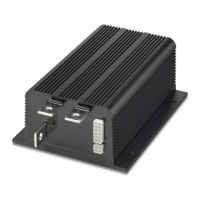Blue Ox Review of wiring diagrams [24 July 2007]
Curtis 1253 Manual, Rev. F
13
Blue Ox Rev. A, draft #1 [3 August 2007]
Single-Ended 0–5V Voltage Source (“Type 2”)
With this throttle (“Type 2” in the Program Menu) the controller looks for
a voltage signal at the Pot Wiper pin. Zero speed corresponds to 0 V and full
speed to 5 V.
2 — INSTALLATION & WIRING: Switches, etc.
Fig. 6 Wiring for
0–5V throttles (“Type 2”).
e active range for this throttle is from 0 V (at 0% rottle Deadband) to
5.0 V (at 100% rottle Max), measured relative to B-. e signal is measured
at the Pot Wiper pin. It is the responsibility of the OEM to provide appropriate
throttle fault detection for 0–5V throttles.
Single-Ended 1k
Ω
–10k
Ω
3-wire pot (“Type 3”)
e 3-wire potentiometer is used in its voltage divider mode, with the voltage
source and return being provided by the 1253 controller. Pot High provides a
current limited 5V source to the pot, and Pot Low provides the return path.
Wiring is shown in Figure 7 and is also shown in the standard wiring diagrams,
Figure 3.
Fig. 7 Wiring for 3-wire
potentiometer throttle
(“Type 3”).
FASTER
1kΩ–10kΩ
Pot Wiper input (Pin J1-3)
Pot Low input (Pin J1-4)
Pot High output (Pin J1-2)
When a 3-wire pot is used, the controller provides full fault protection.
Potentiometers with total resistance values between 1 kΩ and 10 kΩ can be used.
CONTACTOR, SWITCHES, and OTHER HARDWARE
Main Contactor
A main contactor should be used with the 1253 controller. Otherwise, the
controller’s fault detection will not be able to fully protect the controller and
hydraulic system from damage in a fault condition. e main contactor allows
the controller and motor to be disconnected from the battery. is provides a
significant safety feature, because it means the battery power can be removed
+
-
0–5V input (Pin J1-3)

